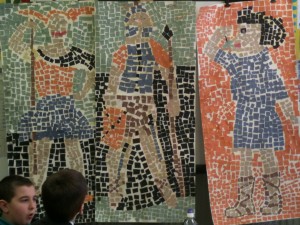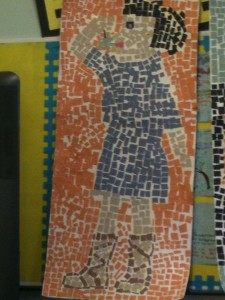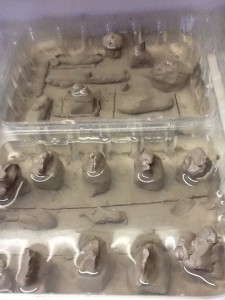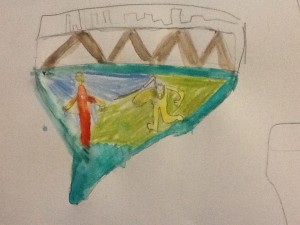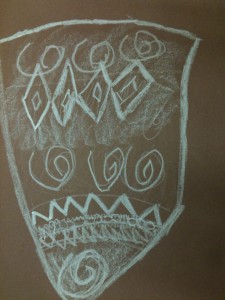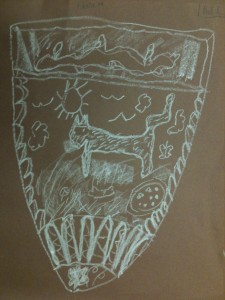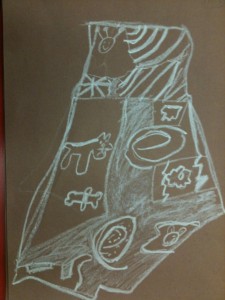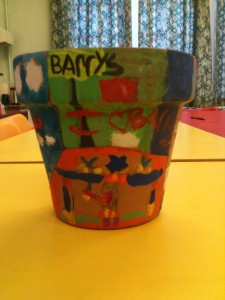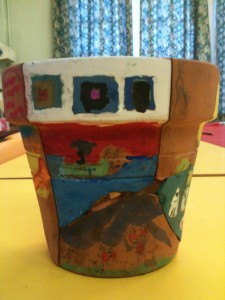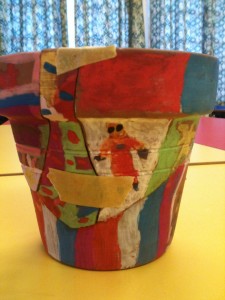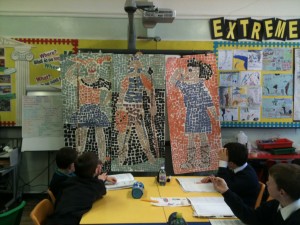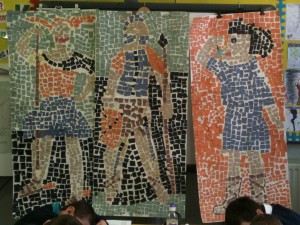Session5
Session 5
January 21st
This session started with Andrew showing us the progress on his house. This served as great encouragement to the children.
Some children were still drawing on the details onto the house , we had cats in windows , flowers in vases even the taps on the kitchen sink were included. The influence of Do Ho Suh was in evidence as his work includes an incredible amount of detail too.
Although they had started sewing last week the bulk of the children hadn’t ever sewn before. It was interesting to see how many of them had no experience whatsoever of using needles and thread. So we had to stop and do a master class on how to sew , how to thread a needle and how to finish off their sewing , they were given an opportunity to practice on a smaller piece before trying to sew on the large panels with just simple running stitches.
Each group steadily sewed their way over their pencil drawings. I was lucky that not only had I the help of my classroom assistant but also Nadine and Chloe both students from the University of Ulster.

Clay Houses
We photographed the clay houses again, the weather has been quite damp and the house are showing the effects .


Session 6
28th January
Andrew connected with us and showed us the progress he’d made with his sewn house, the children were very impressed and it spurred them on to work on their own panels , as this was to be our last session working on them.
The children continued to sew their panels . They have been working together effectively to sew the large panels and they have been quite focussed on their task, the classroom is quiet and busy . Lots of skills are being learnt, learning to thread a needle,learning how to finish off their sewing ,sewing in a straight line, making sure the fabric doesn’t get puckered . The children worked very hard to complete the panels and they are looking forward to next week’s session.


Session 7
8th February
Excitement!!!
This is the day we were going to create a ‘classroom storm’.
I stitched together the four panels that made up the sides of the house, then put string across the classroom and suspended the house from the string. It looked really well. We had three electric fans set up in different positions in the classroom and had pushed the desks back ready for the storm.
We connected with Andrew and he explained to the children that they were going to create a storm in the classroom. He had asked the children to bring in torches and then showed them what they were going to use them for.
First they had to cut a silhouette from paper, a shape of something that would be caught and blown about in a storm. The children chose a variety of things to cut from clothes to chairs . Then he demonstrated how they would use the torches to shine through the shapes , these would be projected onto the house and moved across and up and down as if blown by the wind.
We discussed how we would create the sounds in a storm the wind and rain also how we could represent lightning by flicking the lights on and off.
The children were put into groups and each group given a different part to play in the ‘storm’ .One group made wind sounds another rain sounds , we had a group using their torches and shinning them through the shapes they had made. A child was given the important job of creating the lightning. These groups were rotated so everyone had a chance to try each part.
So …..we had all the elements we needed for the storm.We had several practice runs , we played around with various ideas and permutations , we recorded all of these.
With fans blowing the house, children projecting their silhouettes ,the sound of the wind and the rain we had drummed up quite a storm, however, the children felt that the storm wasn’t dramatic enough so they suggested that we needed some screams, again volunteers weren’t hard to find!
After all our practice runs it was time for the real event ….cameras were positioned ,the children well primed and ……off we went ‘the perfect classroom storm’ was created.
The sense of achievement the children have gained is amazing , they all felt that they had taken part in something special and something that was of their own creation. A piece of performance art in the classroom, Brilliant!

Clay Houses
Some of the houses are showing quite a lot of wear and tear , some are splitting and cracking others are quite pitted .

Session 8
11th February
This session was linked to our extreme weather topic in particular how flooding has become a problem globally and also in the UK . We were able to look at recent news clips and see the devastation that flooding, causes.
As a contextual link, Andrew had given me the work of Marc Quinn to reference for the children, in particular his silicon Oil flower forests they were intrigued by the images , how the flowers were ‘caught in time’ by the silicone and wouldn’t ever decay , unlike flowers submerged in water.
Once we had discussed the work the children were keen to get started.The children had brought in clear plastic trays and at this point weren’t too sure what they were to be used for I also had clay already prepared for them . Andrew talked to the children about what they were to do, he explained that they were to create a little street scene ,including their own house just as they had drawn in our first session . Andrew talked to them about how they were to first of all plan their scene sketching out the shape of their container from a side view and then from a birds eye view,they then continued by drawing all the elements they were putting in their scene . Andrew explained how they would need to include as much detail as they could .
The children then set about filling their clear trays with a layer of clay to set their scene,then they began moulding their miniature environments. The children loved making their little houses , they also became quite absorbed in creating all the other elements in their scene, things like garden walls,hedges and ponds ,several makes of cars appeared .The silence in the room bore testament to the children’s involvement in what they were creating.
Once they had completed all their scenes Andrew then told them the devastating news that they were going to flood their scenes! The children really were quite concerned about their work and how the water would affect them. This led to a discussion about how people who had their houses flooded during the bad weather must feel .The children talked about all the things that would be ruined in a house after flooding .
We then poured the water over their scenes, the children will watch and see what happens to their scenes over the next few weeks and we will photograph the changes .
It was interesting that through this activity the children were able to empathise with flood victims in a way that they perhaps wouldn’t have done before .

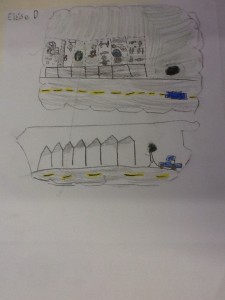
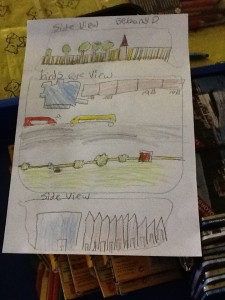
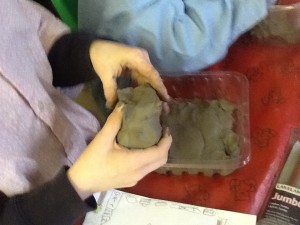
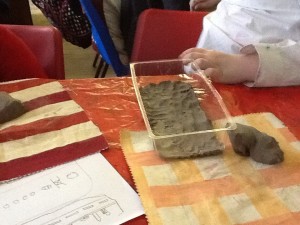
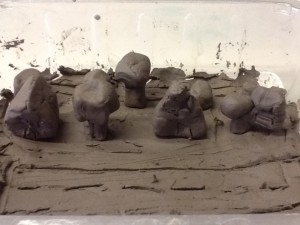
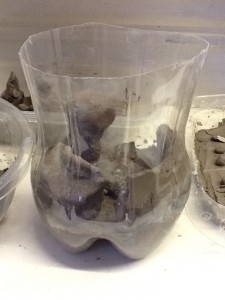
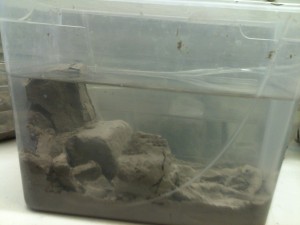
Clay Houses
The house have quite a lot of debris building up around them in particular leaves seem to have been blown onto them . Some houses still show a surprising amount of detail.
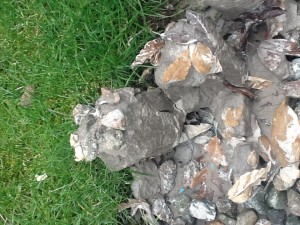
Session 9
22 nd February
The start of a new topic! The children are researching the Romans and Andrew linked up our studies with this topic.
The children first looked Archaeologists and how they go about their work.How they organise their digs? The tools they used? How they looked after the artefacts they found ? And how so many of these things were the everyday objects that we still would use today. Many of these objects were made of clay the children were able to appreciate how these in particular had survived the passage of time.
Andrew then talked to the children about how the museums would conserve these objects ,even pieces of pots were carefully pieced together If all the parts weren’t there , they could construct the pot and fill in the missing parts with plaster, so that the structure of the pot was still able to be seen.
Once the children had this background knowledge Andrew then explained to them what they were going to do………
My part in this was to prepare terracotta flower pots I took to them with a hammer! and smashed them into shards ,I enjoyed doing that I have to say. These shards were then labelled pot A,pot B,pot C etc (we used 4 flowerpots) and were given out randomly to the children, they drew around these onto paper ( slightly larger than life size) .Andrew explained to the children that quite often the Roman pots would tell a story and he would like them to tell a story on their piece of pot.
The children set to work and using pencil and painting pencils and produced beautiful coloured sketches, many told stories about what they had done through half term ,some decided to stick to the roman theme and drew soldiers in battle, some drew inspiration from the patterns they saw on the roman pots and on other roman art. They then transferred these onto their terracotta shards. Once they had sketched these they then painted on their shards.
The children were very absorbed in their work today and worked hard to achieve the fantastic results they did. It was a very successful session.
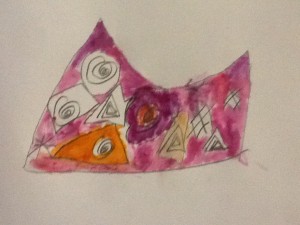

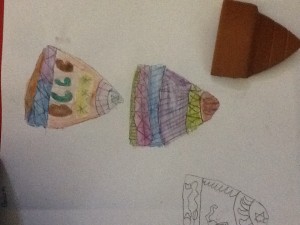

Clay houses
The children wanted to touch the houses this week and they were quite surprised that although they looked squashy they were in fact quite hard . I think it would be quite interesting to fire them after the project is over
Session 10
25th February
This session was a continuation of the previous one when we connected up with Andrew he chatted to the children about how museums would piece together pots using the labels to identify where the pieces fitted together. The children were quite intrigued and began trying to fit their bit with others at their table ,some did match but as they were given out randomly it didn’t happen often.
Andrew showed the children his completed shard and how it fitted into his pot. He then explained that they were going to draw the shape of the shard onto brown paper larger than it is , then ,using white pastel draw their design onto the paper . The children then set to work and as the drawing was just in white ,they used tone ,patterns and textures to add details .
As they were drawing, each child that had shards belonging to a particular pot came up and we pieced them together, gluing them into place. They looked fantastic as I hope you can see from the photos.
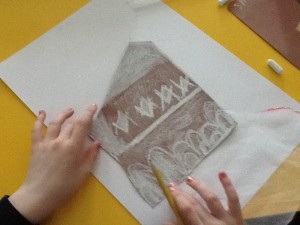
We connected with Andrew and he chatted to the children about how they were going to use their white shard drawings to cut out the shape of a roman pot.
I found it interesting how Andrew’s thinking of our topic has taken the children down pathways I would never have thought of. I liked how one piece of work informed another and pushed the children to think further.
Andrew explained again to the children how in museums they piece together pots like jigsaws and if any pieces are missing they fill the gap with plaster. He then explained to the children that they were going to ‘shatter’ their pot into shards and then piece them together by sticking them down onto paper.
We looked again at a range of pot shapes and discussed how certain pot shapes would suit their drawings, they had to choose very carefully. We also discussed how thinking of symmetry would help them plan and cut out their pot shape.
Some children used a tracing paper stencil that they drew and cut out themselves , to guide them, some children found it just as easy to cut out their shard and then fold it down the middle and cut out their pot shape.
Then they had great fun trying to piece the pieces back together, they had to remember to leave a gap between each piece to look like a reassembled pot.
The pots were looking fantastic.
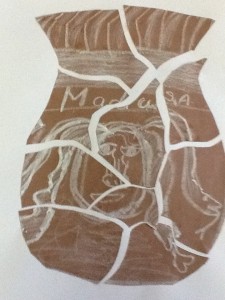
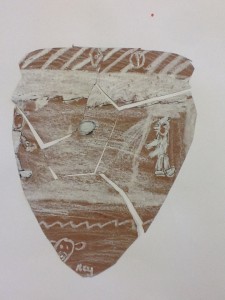
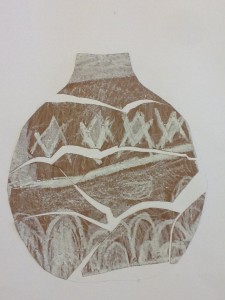
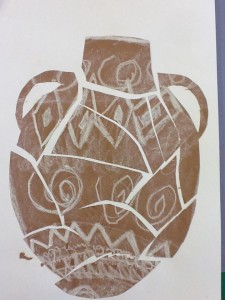
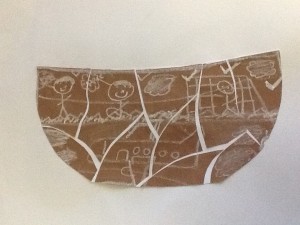
Session 12
11th March
Our final session with Andrew!
All of us were really sad that this would be our last contact with Andrew . Unbeknownst to the children Andrew had flown over to Belfast for the last session . So, as I made a great fuss about not getting connected on the IWB a knock came to the door and Andrew walked in there was a stunned silence then a little voice from the back of the class said
“It’s Andrew!”
The children were so surprised , it was brilliant watching their faces as they realised the man they usually saw on the screen was actually in the room ! After everyone had calmed down Andrew was able to get started on the activity for the day.
The children had three large sheets of cardboard and they had drawn around three of the smaller children on these. Andrew had already explained that they were going to make these figures into large paper mosaic panels . All the paper squares had been prepared the previous week so all they had to do was start to stick them down, making sure they left a small space between each piece of paper. The children had selected the range of colours they chose colours which were quite earthy. They worked really hard and the resulting figures were super.
It was great having Andrew there the children asked him questions and consulted him about what they were doing. The children were very keen to show him all the work that they had completed throughout the whole project and took Andrew on a tour to show him.
The work was displayed throughout the school for everyone to see. As it was parent interview week in school, lots of parents got to see the work including my class’s parents. Everyone was very impressed and could see the amount of thought and work that had gone into the whole project.
For me it has been another super experience ,I love working with Andrew and his way of thinking always takes me and the children down surprising and stimulating paths.
